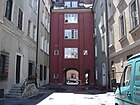Old Town, Warsaw
Old Town | |
|---|---|
UTC+2 (CEST ) |
| UNESCO World Heritage Site | |
|---|---|
| Location | Warsaw, Mazovia Province, Poland |
| Criteria | Cultural: (ii), (vi) |
| Reference | 30bis |
| Inscription | 1980 (4th Session) |
| Extensions | 2014 |
| Area | 25.93 ha (64.1 acres) |
| Buffer zone | 666.78 ha (1,647.6 acres) |
Warsaw Old Town,
During
History

The Old Town was established in the 13th century. Initially surrounded by an earthwork rampart, prior to 1339 it was fortified with brick



Until 1817 the Old Town's most notable feature was the Town Hall built before 1429. In 1701 the square was rebuilt by Tylman Gamerski, and in 1817 the Town Hall was demolished. Since the 19th century, the four sides of the Market Square have borne the names of four notable Poles who once lived on the respective sides: Ignacy Zakrzewski (south), Hugo Kołłątaj (west), Jan Dekert (north) and Franciszek Barss (east).
In the early 1910s, Warsaw Old Town was the home of the prominent
In 1918 the
During the
After
Squares
The Old Town Market Place (Rynek Starego Miasta), which dates back to the end of the 13th century, is the true heart of the Old Town, and until the end of the 18th century it was the heart of all of Warsaw.[13] Here the representatives of guilds and merchants met in the Town Hall (built before 1429, pulled down in 1817), and fairs and the occasional execution were held. The houses around it represented the Gothic style until the great fire of 1607, after which they were rebuilt in late-Renaissance style.[14]
Castle Square (plac Zamkowy) is a visitor's first view of the reconstructed Old Town, when approaching from the more modern center of Warsaw. It is an impressive sight, dominated by Sigismund's Column, which towers above the beautiful Old Town houses. Enclosed between the Old Town and the Royal Castle, Castle Square is steeped in history. Here was the gateway leading into the city called the Kraków Gate (Brama Krakowska).[15] It was developed in the 14th century and continued to be a defensive area for the kings. The square was in its glory in the 17th century when Warsaw became the country's capital and it was here in 1644 that King Władysław IV erected the column to glorify his father Sigismund III Vasa, who is best known for moving the capital of Poland from Kraków to Warsaw.[15] The Museum of Warsaw is also located there.
Canon Square (plac Kanonia), behind
Recognition
In 1980, Warsaw's Old Town was placed on the UNESCO's list of World Heritage Sites as "an outstanding example of a near-total reconstruction of a span of history covering the 13th to the 20th century.[10]
The site is also one of Poland's official national
In 2011, the Archive of Warsaw Reconstruction Office was added to UNESCO’s Memory of the World Programme.[7]
Gallery
-
1:300 model of Warsaw Old Town in 2nd half of 18th century, in Museum of Warsaw
-
Palace Square
-
Warsaw old town wide (Rynek Starego Miasta)
-
Reconstructed townhouses
-
Road to the Old Town
-
Market Square
-
An alley
-
Medieval basements at the Museum of Warsaw
-
Historical houses around Castle Square.
-
Old Town Market Place with tourists
-
Statue of the mermaid (Old Town).
-
Jan Kiliński monument
-
Warsaw Old Town surrounded by the old medieval defensive walls.
-
Defensive walls and the Barbican
-
Old Town street
-
Old Town.
-
St. John's Cathedral, 14th century[18]
-
Jesuit Church, 1609[18]
-
St. Martin's Church, 1353-1752[18]
-
Warsaw Barbican, 1548
-
Gunpowder Tower, after 1379
-
Defensive walls, detail
-
Szeroki Dunaj Street
-
Piwna Street
-
QueenSigismund IIIwas attacked by an assassin in the corridor before attending mass
-
Canonicity Square
-
St John Street
See also
Notes
References
- ^ a b c Encyklopedia Warszawy. Warsaw: Polish Scientific Publishers PWN, 1994, p. 806. ISBN 83-01-08836-2.
- ^ "Obszary MSI. Dzielnica Śródmieście". zdm.waw.pl (in Polish).
- ^ Jerzy Lileyko: Najcenniejsze Zabytki Warszawy. Warsaw: Krajowa Agencja Wydawnicza, 1989, p. 30–36. ISBN 83-03-02485-X.
- ^ Robert Krzysztofik: Lokacje miejskie na obszarze Polski. Dokumentacja geograficzno-historyczna, Katowice, 2007, p. 80-81.
- ^ Stuart Dowell (21 July 2023). "Monumental reconstruction of Warsaw's Old Town which was devastated by WWII completed 70 years ago". thefirstnews.com. Retrieved 22 July 2023.
- ^ "Historic Centre of Warsaw". UNESCO World Heritage Centre. Archived from the original on 15 March 2017. Retrieved 22 July 2023.
- ^ a b "Archive of Warsaw Reconstruction Office". en.unesco.com. Retrieved 22 July 2023.
- ^ "Kamienica "Pod Okrętem"". ePrzewodnik / Perełki Warszawy on-line (in Polish). Retrieved 2009-03-16.
- ^ "Historic Centre of Warsaw". whc.unesco.org. Retrieved 2008-08-18.
- ^ a b c "Old Town". www.destinationwarsaw.com. Retrieved 2008-08-18.
- ^ "Warsaw's Old Town". www.ilovepoland.co.uk. Retrieved 2008-08-18.
- ^ 99% invisible episode 72
- ^ "The Old Town Market Square". eGuide / Treasures of Warsaw on-line. Retrieved 2008-07-08.
- ^ Marek Lewandowski. "Rynek Starego Miasta". www.stare-miasto.com (in Polish). Archived from the original on 2016-03-03. Retrieved 2008-07-08.
- ^ a b "Plac zamkowy". zapiecek.com (in Polish). Retrieved 2008-07-01.
- ^ a b c d "Canonicity". eGuide / Treasures of Warsaw on-line. Retrieved 2009-05-12.
- ISBN 83-01-03323-1.
- ^ a b c "Kościoły w Warszawie - Stare Miasto". List of churches located in the Old Town in Warsaw.

















![St. John's Cathedral, 14th century[18]](http://upload.wikimedia.org/wikipedia/commons/thumb/e/eb/4_Warszawa_12.jpg/120px-4_Warszawa_12.jpg)
![Jesuit Church, 1609[18]](http://upload.wikimedia.org/wikipedia/commons/thumb/8/89/Ko%C5%9Bci%C3%B3%C5%82_Matki_Bo%C5%BCej_%C5%81askawej_w_Warszawie_2020.jpg/105px-Ko%C5%9Bci%C3%B3%C5%82_Matki_Bo%C5%BCej_%C5%81askawej_w_Warszawie_2020.jpg)
![St. Martin's Church, 1353-1752[18]](http://upload.wikimedia.org/wikipedia/commons/thumb/1/13/Kosciol_sw_marcina_warszawa.jpg/135px-Kosciol_sw_marcina_warszawa.jpg)








